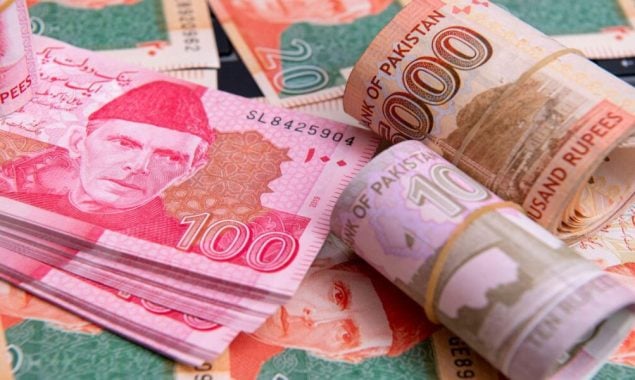
Image Courtesy: File
KARACHI: High dollar demand for external payments, depleting foreign exchange reserves and the rising oil prices in the international market are likely to keep the Pakistani rupee under pressure, experts said.
However, they brushed off speculation that the rupee may fall to 200 against the dollar.
“The Federal Board of Revenue (FBR) had issued notices for the recovery of 16 per cent federal excise duty (FED) on the transactions of exchange companies. These reports created a panic in the market,” Malik Bostan, chairman of the Exchange Companies Association of Pakistan, said.
“We talked to Finance Minister Shaukat Tarin and apprised him of the negative impact it would have on the exchange rate.”
“Since the 16 per cent FED proposed on the exchange companies was withdrawn, there was no chance of the US dollar hitting Rs200,” he added.
Bostan said oil prices in the international market were increasing and the country’s demand was multiplying, which would inflate the import bill.
“The rising oil prices have a direct impact on the rupee value. The government needs to limit oil products’ consumption and the influx of combustion engine vehicles in the market.”
Wajid Rizvi, an analyst at JS Global Capital, said a threefold impact of low inventories, low spare production capacity and low investments was making the oil rally stronger, amid resilient demand.
“The recent rally in oil continues to shrug off the concerns from the Omicron regional lockdowns, as most of the economic activity throughout the globe has not impaired to a considerable extent,” he said.
“This has been added on by unrest in Kazakhstan, which impacts 1.8 million bpd oil supplies from Opec+ to the global oil market.”
Consequently, high international oil prices are a bad omen for the countries such as Pakistan, as the petroleum products are the main import item.
“Our base case estimate for oil import bill of $20 billion for FY22 assumes an average oil price of $75/bbl and every $5/bbl higher can increase the import bill estimate by $1.2 billion (0.3 per cent of GDP),” Rizvi said.
Khawaja Amjad Waheed, CEO of NBP Funds, said the consequence of the robust recovery in domestic demand, amid sharp surge in the global commodity prices had been a hefty increase in the import bill.
“Though the exports have also rebounded, there are rising concerns on the balance of payments position since Pakistan’s imports considerably outweigh the exports,” Waheed said.
He said the recently enacted policy actions such as large currency depreciation, broadening the scope of 100 per cent cash margin requirement on imports, temporarily regulatory duties on the non-essential imported items and tapering of the monetary stimulus by the State Bank of Pakistan (SBP) were expected to contain the import bill, going forward.
“We expect the current account deficit to increase to $13.5 billion for FY22 due to a pick-up in the economy and increased commodity prices in the international markets,” Waheed added.
The foreign exchange reserves of the SBP improved from $13.4 billion at CY20-end to around $17.9 billion at CY21-end on the back of flows from multilateral agencies such as the Asian Development Bank (ADB) and the World Bank and the Kingdom of Saudi Arabia.
“We expect foreign exchange reserves to remain stable due to the expected resumption of the International Monetary Fund (IMF) programme, which will make available 750 million in Special Drawing Rights (equivalent to $1,059 million), and the planned issuance of the international bonds in the first half of CY22.” The local currency remained under pressure, despite the measures taken by the State Bank of Pakistan regarding restrictions on realising the export receipts to provide support to the rupee.
On January 5, 2022, the SBP directed the exporters to realise their export receipts within 120 days from the date of shipment instead of 150 days.
Bostan said the central bank didn’t have much in its domain such as the import bill.
“Pakistan is importing way more than its requirement. If we keep importing from Iran and Afghanistan, there is nothing the central bank can do.”
The local currency remained under pressure since the start of the current fiscal year due to higher external payments. The rupee fell 18.95, or 12.02 per cent, from Rs157.54 to the dollar on June 30, 2021 to Rs176.49 on January 24, 2022.
Read More News On
Catch all the Business News, Breaking News Event and Latest News Updates on The BOL News
Download The BOL News App to get the Daily News Update & Follow us on Google News.




